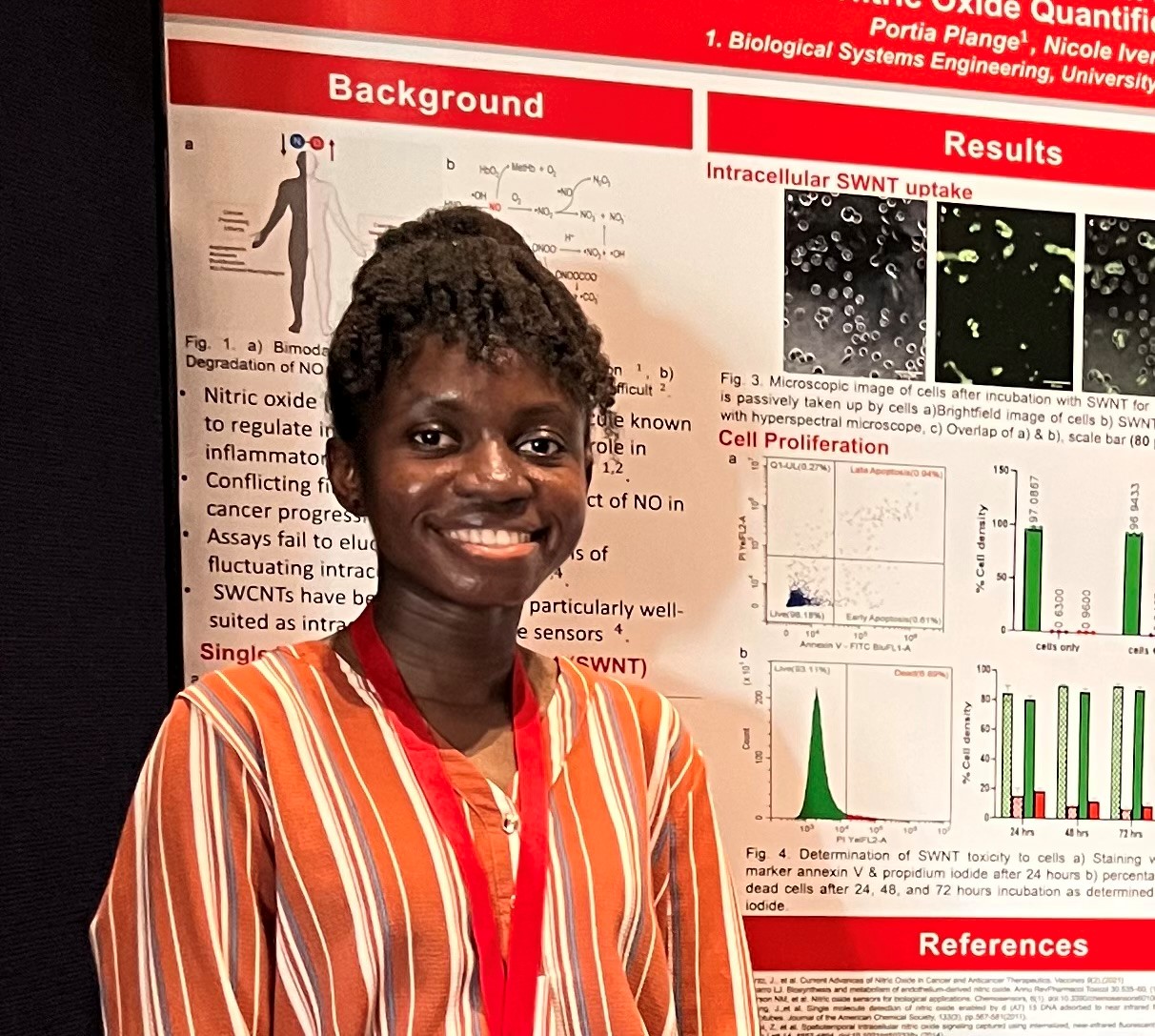Nano and Micro Technologies
(G-258) Development of Single-Walled Carbon Nanotube Sensor for Organelle-Specific Nitric Oxide Quantification in Cancer Cells
Thursday, October 12, 2023
2:00 PM - 3:00 PM PDT
Location: Exhibit Hall - Row G - Poster # 258

Portia Plange
Research Assistant
University of Nebraska-Lincoln
Lincoln, Nebraska, United States- NI
Nicole Iverson
Professor
University of Nebraska Lincoln
Lincoln, Nebraska, United States
Presenting Author(s)
Primary Investigator(s)
Introduction:: Nitric oxide (NO) is a key signaling molecule known to regulate immune response and plays a role in inflammatory diseases, including cancer. However, there are conflicting findings on the bimodal effect of NO in cancer progression, with suggestions of high concentrations of NO leading to both pro- and anti-cancer effects. This misunderstanding of NO’s impact on cells is likely due to measurements of only upstream/downstream NO products instead of the actual NO concentration, which occurs because of NO’s short half-life. A DNA-wrapped single-walled carbon nanotube sensor ((AT)15-SWNT) has been proven to provide spatiotemporal detection of NO. It is hypothesized that this (AT)15-SWNT sensor can be used to detect the real-time NO levels in cancer cells, allowing for the quantification of intracellular NO levels and information about cancer progression.
Materials and Methods:: Hyperspectral microscopy is used to determine if the (AT)15-SWNT sensors are taken up by MDA-MB 231 (triple negative breast cancer) cells. Flow cytometry (annexin-PI dye), migration assays, and actin staining dyes, are used to test the impact of SWNT on the cells’ viability, metastasis, and cell morphology respectively. Intracellular staining dyes are then used together with the hyperspectral microscope to determine the spatiotemporal localization of the sensor in the cells. Origin pro, ImageJ, and MATLAB were used for data analysis.
Results, Conclusions, and Discussions:: Results and Discussion: Results show that the presence of 10 mg/L (AT)15-SWNT does not significantly alter cell viability, proliferation, or morphology, suggesting a lack of toxicity from the (AT)15-SWNT. Therefore, the sensor can be used to determine what is occurring within the cells without altering basic cell functions. SWNT fluorescence can be detected after staining various organelles of interest, specifically the nucleus, mitochondria, and lysosome, providing localization information for the sensors and the capability to quantify the NO associated with each location.
Conclusions: We have shown that the NO sensors can be internalized by triple-negative breast cancer cells without altering cell function. We have also labeled intracellular organelles while delivering and visualizing the SWNT sensors, demonstrating the capability of the (AT)15-SWNT to act as a real time NO sensor for specific intracellular locations. These results will enable researchers to learn more about the impact of NO on different types of cancer cells and potentially create a better cancer-treatment option in the future.
Acknowledgements (Optional): : I would like to thank the Iverson lab members, Dr. Nicole Iverson and NIH 5R35GM138245 for funding this project.
References (Optional): :
Materials and Methods:: Hyperspectral microscopy is used to determine if the (AT)15-SWNT sensors are taken up by MDA-MB 231 (triple negative breast cancer) cells. Flow cytometry (annexin-PI dye), migration assays, and actin staining dyes, are used to test the impact of SWNT on the cells’ viability, metastasis, and cell morphology respectively. Intracellular staining dyes are then used together with the hyperspectral microscope to determine the spatiotemporal localization of the sensor in the cells. Origin pro, ImageJ, and MATLAB were used for data analysis.
Results, Conclusions, and Discussions:: Results and Discussion: Results show that the presence of 10 mg/L (AT)15-SWNT does not significantly alter cell viability, proliferation, or morphology, suggesting a lack of toxicity from the (AT)15-SWNT. Therefore, the sensor can be used to determine what is occurring within the cells without altering basic cell functions. SWNT fluorescence can be detected after staining various organelles of interest, specifically the nucleus, mitochondria, and lysosome, providing localization information for the sensors and the capability to quantify the NO associated with each location.
Conclusions: We have shown that the NO sensors can be internalized by triple-negative breast cancer cells without altering cell function. We have also labeled intracellular organelles while delivering and visualizing the SWNT sensors, demonstrating the capability of the (AT)15-SWNT to act as a real time NO sensor for specific intracellular locations. These results will enable researchers to learn more about the impact of NO on different types of cancer cells and potentially create a better cancer-treatment option in the future.
Acknowledgements (Optional): : I would like to thank the Iverson lab members, Dr. Nicole Iverson and NIH 5R35GM138245 for funding this project.
References (Optional): :
